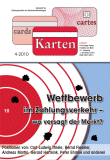Sie befinden sich hier: Home › cards › Ergänzende Informationen › Archivdaten › The envisaged regulation willfail to achieve the Sepa objectives
Archivdaten
01.11.2010
Wettbewerbsstrategien
The envisaged regulation willfail to achieve the Sepa objectives

Dieser Artikel ist Teil unseres Online-Abo Angebots.
cards Karten cartes, Ausgabe vom 01.11.2010, Seite 024
Archivdaten
2,60 €
2905